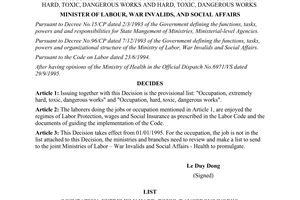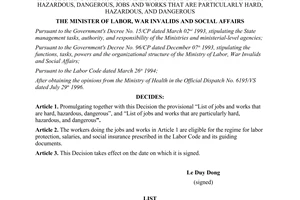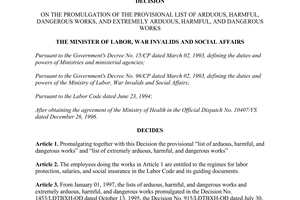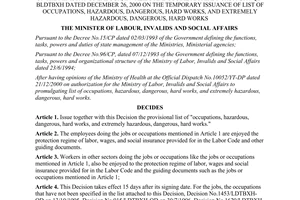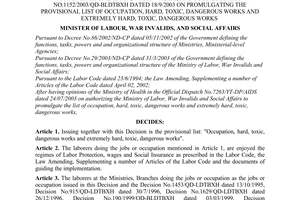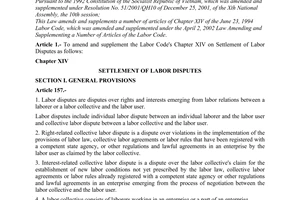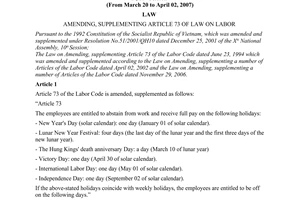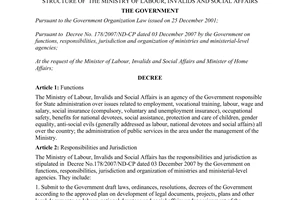Nội dung toàn văn Circular No. 36/2012/TT-BLĐTBXH list of arduous toxic dangerous works
|
MINISTRY OF
LABOR, WAR INVALIDS AND SOCIAL AFFAIRS |
SOCIALIST
REPUBLIC OF VIETNAM |
|
Hanoi, December 28, 2012 |
CIRCULAR
ON THE SUPPLEMENTATION OF THE LIST OF ARDUOUS, HARMFUL, DANGEROUS WORKS, AND EXTREMELY ARDUOUS, HARMFUL, AND DANGEROUS WORKS
Pursuant to the Labor Code dated June 23, 1994, the Law on the amendments to the Labor Code dated April 02, 2002; the Law on the amendments to the Labor Code dated June 29, 2006; the Law on the amendments to the Labor Code dated April 02, 2007;
Pursuant to the Law on Social insurance dated June 29, 2006;
Pursuant to the Government's Decree No. 186/2007/NĐ-CP on December 25, 2007 on defining the functions, tasks, powers and organizational structure of the Ministry of Labour, War Invalids and Social Affairs;
At the request of the Director of the Department of Labor safety;
The Minister of Labor, War Invalids and Social Affairs supplements the list of arduous, harmful, dangerous works, and extremely arduous, harmful, and dangerous works,
Article 1.
1. Supplementing the List of arduous, harmful, and dangerous works and extremely arduous, harmful, and dangerous works in the Appendix to this Circular.
2. This Circular is applicable to all organizations, enterprises and individuals that employ workers in Vietnam, including international organizations, unless otherwise prescribed by International Agreements to which Vietnam is a signatory.
Article 2.
1. Employers are responsible for ensuring that the employees that do the works in Clause 1 Article 1 and Clause 2 Article 2 of this Circular benefit from the personal protective equipment, wages, and social insurance in the Labor Code, the Laws on amendments to the Labor Code, and their guiding documents.
2. The employees doing the works similar to the works in this Circular and the Decision No. 1453/LĐTBXH-QĐ dated October 13, 1995, the Decision No. dated October 13, 1995, the Decision No. 915/LĐTBXH-QĐ dated July 30, 1996, the Decision No. 1629/LĐTBXH-QĐ dated December 26, 1996, the Decision No. 190/1999/QĐ-BLĐTBXH dated March 03, 1999, the Decision No. 1580/2000/QĐ-BLĐTBXH dated December 26, 2000, the Decision No. 1152/2003/QĐ-BLĐTBXH dated September 18, 2003 of the Minister of Labor, War Invalids and Social Affairs entitled to the personal protective equipment, wages, and social insurance similar to those of the works in the promulgated documents.
Article 3.
This Circular takes effect on May 01, 2013.
Difficulties that arise during the implementation should be reported to the Ministry of Labor, War Invalids and Social Affairs for consideration./.
|
|
PP THE MINISTER |
LIST
EXTREMELY ARDUOUS,
HARMFUL, DANGEROUS WORKS (CLASS VI AND CLASS V), AND ARDUOUS, HARMFUL, AND
DANGEROUS WORKS (CLASS IV)
(promulgated together with the Circular No. 36/2012/TT-BLĐTBXH dated
December 28, 2012 of the Ministry of Labor, War Invalids and Social Affairs)
A. Mining
|
No. |
Occupation or work |
Working conditions |
|
Working conditions of class VI |
||
|
1 |
Mine rescuers. |
Extremely dangerous. |
|
2 |
Extracting non-ferrous metal ore underground. |
Working in confined spaces, lacking oxygen, manual, very arduous and dangerous works, under the impact of dust, noise, and CO2 |
|
3 |
Operating pyrometallurgy or hydrometallurgy equipment (copper, zinc, tin, titanium, chrome, wolfram, etc.) |
Working in a hot and dusty environment with arsenic, noxious gases and chemicals |
|
Working conditions of class V |
||
|
1 |
Extracting non-ferrous metal ore outdoors or semi-outdoors. |
Manual works, hot, constantly in contact with noxious dust, lacing oxygen. |
|
2 |
Operating equipment for separating non-ferrous metal ore by flotation, gravity separation, magnetic separation (separating, soaking, extracting, etc.) |
Under the impact of loud noise, dust, toxic chemicals, arsenic, metal oxides, etc. |
|
3 |
Operating pyrometallurgy or hydrometallurgy equipment (copper, zinc, tin, titanium, chrome, wolfram, etc.) |
Constantly in contact with high temperatures, arsenic, noxious gases and chemicals. |
|
4 |
Workers, safety supervisors in the mine; operating and repairing equipment, operating electric trams in the mine; operating, repairing, and recharging batteries in the mine; assessing products, keeping warehouses , cleaning cesspit, dredging, moving materials, signaling, doing catering in the mine; installing, repairing communications system, watching ventilation hatches, measuring air and wind in the mine. |
Working in confined spaces, dangerous works, static working posture; under the impact of noise, coal dust, and CO2. |
|
5 |
Electrolysis workers (keeping, moving anodes and cathodes, residue), producing copper ingots. |
Working in a hot and dusty environment with noxious gases and chemicals; facing the high risk of acid burn |
|
6 |
Processing electrolytic residue, collecting precious metal during the production of non-ferrous metal. |
Constantly in contact with high temperatures, arsenic, noxious gases and metal acids, etc. |
|
7 |
Repairing non-ferrous metal smelters. |
Constantly in contact with high temperatures, arsenic, noxious gases and metal acids, etc. |
|
8 |
Industrial sanitation in non-ferrous metal production. |
Manual works, hot, constantly in contact with noxious dust, gases, and solvents |
B. Chemical industry
|
No. |
Occupation or work |
Working conditions |
|
Working conditions of class VI |
||
|
1 |
Producing and packaging yellow phosphorus (P4). |
Working at a height, next to hot kilns, in direct contact with dust (of quartzite, apatite, coke), noxious gases (CO, P2O5, PH3, HF, P4...), noise; facing high risk of poisoning and explosive. |
|
Working conditions of class V |
||
|
1 |
Producing and packaging Al(OH)3. |
Constantly in contact with NaOH, moisture, and dust at high temperature. |
|
2 |
Operating conveyor belts to supply sulfur; operating sulfur burners to produce H2SO4. |
Constantly under the impact of heat, noise, and high concentration of SO2 and H2S. |
|
3 |
Operating cranes to scramble superphosphate. |
Constantly in contact with dust, noise, and very high concentration of fluorine and H2S. |
|
4 |
Producing ZnCl2. |
Constantly in contact with high temperatures, CO, HCl, H2S. |
|
Working conditions of class IV |
||
|
1 |
Operating coal burners in chemical production. |
Manual works, constantly in contact with dust, heat, and high concentration of CO2 and SO2. |
|
2 |
Producing Na2SiO3. |
Constantly in contact with high temperatures, silicon dust, and Na2CO3. |
|
3 |
Producing aluminum chloride (P.A.C); producing CaCl2. |
Constantly in contact with high temperatures and HCl vapor. |
C. Customs
|
No. |
Occupation or work |
Working conditions |
|
Working conditions of class IV |
||
|
1 |
Operating luggage scanners. |
Under the impact of radiation and electromagnetic field. |
|
2 |
Operating cargo scanners. |
Under the impact of radiation and electromagnetic field. |
|
3 |
Vessel supervisors. |
Outdoor works; under the impact of noise and electromagnetic field. |
|
4 |
Supervising container depots. |
Outdoor works; under the impact of noise and electromagnetic field. |
|
5 |
Supervising aircraft stands in international airports. |
Outdoor works; under the impact of noise and electromagnetic field. |
|
6 |
Using customs speedboats and diesel boats for patrols and prevention of smuggling at sea (captains, first mates, chief engineers, crewmembers). |
Under the impact of bad weather, noise, tremor, and heat; static working posture; constantly in contact with oil and gas. |
|
7 |
Training and using detection dog to detect drugs, weapons, and prevent smuggling across the border. |
Constantly in contact with sources of pathogens from detection dogs, wastes, and pathogenic bacteria. |
|
8 |
Analyzing, classifying exported goods and imported goods (working in laboratories with chemicals). |
Constantly in contact with toxic chemicals, noise, and chemical dust. |
|
9 |
Keeping and preserving chemicals serving the analysis and classification of exported goods and imported goods. |
Arduous works; under the impact of toxic chemicals and chemical dust. |
D. Transportation
|
No. |
Occupation or work |
Working conditions |
|
Working conditions of class V |
||
|
1 |
Working in Hai Van tunnel (operating machines and devices; fire safety, maintenance, cleaning, ensuring traffic safety, evacuation). |
Under the impact of magnetic field due to resonance of electrical equipment; under the impact of noise, petroleum gas, noxious gases and dust; under the impact of extreme climate at a height of 127 m above the sea; under the impact of sewage and detergent while cleaning the tunnel; lacking oxygen; facing high risk of occupational accidents and traffic accidents. |
|
2 |
Train dispatchers. |
Very complicated and stressful works. |
|
3 |
Operating gantry cranes. |
Working at a height with violent tremor; highly unsafe. |
|
4 |
Operating multi-function cranes |
Working at a height with violent tremor; highly unsafe. |
|
5 |
Operating wheel-mounted cranes |
Working in dusty, noisy environment with high intensity of labor. |
|
6 |
Operating reach stackers. |
Working in dusty, noisy environment with high intensity of labor. |
|
7 |
Operating forklift trucks (used for other cargo than containers). |
Working in dusty, noisy environment with high intensity of labor. |
|
8 |
Driving trucks in the loading line. |
Working in dusty, noisy environment with high intensity of labor. |
|
9 |
Manual loading. |
Working in dusty, noisy environment with high intensity of labor; arduous and dangerous works. |
|
Working conditions of class IV |
||
|
1 |
Directly managing and operating Hai Van tunnel (working at Operation Control Center); protecting the ventilation system; cleaners, arborists). |
Under the impact of strong magnetic field, noise, petroleum gas, noxious gases; under the impact of extreme climate at a height of 127 m above the sea; under the impact of sewage and detergent while cleaning the tunnel; lacking oxygen, dusty, smoky, facing high risk of occupational accidents and traffic accidents. |
|
2 |
Bridge workers. |
Involving a lot of travel; arduous outdoor works; under the impact of dust, noise, noxious gases; facing high risk of occupational accidents and traffic accidents. |
|
3 |
Tollbooth collectors and their assistants. |
Under the impact of dust, noise, petroleum gases, noxious gases (CO, CO2, etc.); working; outdoors facing high risk of traffic accidents. |
|
4 |
Painting speed humps and median barrier |
Under the impact of dust, noise, petroleum gases, noxious gases (CO, CO2, etc.); working outdoors at high risk of traffic accidents. |
|
5 |
Operating road graders. |
Arduous works; under the impact of noise, tremor, and dust. |
|
6 |
Refueling locomotives and carriages |
Hazardous works; constantly in contact with gasoline, oil, and petroleum products. |
|
7 |
Operating and controlling railway bridges. |
Constantly in contact with excess dust and noise. |
|
8 |
Derusting metal. |
Arduous works; static working posture, under the impact of very thick dust, noise, and tremor. |
|
9 |
Operating rammers, punching machines, impact wrenches, |
Arduous works; under the impact of violent tremor and noise. |
|
10 |
Producing concrete (concrete sleepers, concrete components, etc.) |
Outdoor, arduous works; under the impact of noise and dust. |
|
11 |
Maintaining and cleaning Thang Long bridge. |
Outdoor works; under the impact of excess dust and noise. |
|
12 |
Flagmen at railroad crossing. |
Outdoor arduous works; under the impact of noise and dust; facing high risk of accidents. |
|
13 |
Ship mechanics. |
Working in dusty, noisy environment with noxious gases; intensive, arduous, and dangerous works |
|
14 |
Officers, sailors, and crewmembers on cargo ships. |
Working in dusty, noisy environment with noxious gases; intensive, arduous, and dangerous works |
|
15 |
Repairing chassis and engines of cars and reach stackers. |
Arduous works; under the impact of dust, noise, and noxious gases. |
|
16 |
Bottling and producing industrial gases. |
Rigid and dangerous works; under the impact dust and noise. |
|
17 |
Checking and repairing pressure vessels |
Dangerous works; under the impact dust and noise. |
E. Tobacco production
|
No. |
Occupation or work |
Working conditions |
|
Working conditions of class IV |
||
|
1 |
Testing quality of tobacco ingredients and cigarettes. |
Organoleptically testing the tobacco quality; constantly in contact with chemicals, nicotine, tar, and tobacco smoke through the respiratory tract. |
|
2 |
Culturing tobacco tissues. |
Constantly in contact with detergents, disinfectants, specimens, tools, growth stimulants and mutagens; in contact with alcohol burners at high temperature |
G. Science and technology
|
No. |
Occupation or work |
Working conditions |
|
Working conditions of class V |
||
|
1 |
Conducting experiments in nuclear physics; conducting chemical-radiation experiments. |
Constantly in contact with radiation sources and toxic chemicals. |
|
2 |
Radiological workers. |
Constantly in contact with radiation sources and toxic chemicals. |
|
Working conditions of class IV |
||
|
1 |
Inspecting exported and imported at depots and warehouses. |
Involving a lot of travel; outdoor arduous works; under the impact of dirt, heat, and cold. |
H. Cipher
|
No. |
Occupation or work |
Working conditions |
|
Working conditions of class V |
||
|
1 |
Operating, repairing, and maintaining film production equipment. |
Working in confined spaces; lacking oxygen; under the impact of noise and noxious gases of materials. |
|
Working conditions of class IV |
||
|
1 |
Keeping, loading, receiving, dispensing cipher documents, equipment and devices. |
Working in closed rooms; lacking light and oxygen; under the impact of dust, chemicals used to preserving documents, and cipher equipment. |
|
2 |
Transporting top secret and urgent documents. |
Working day and night; involving a lot of travel; dangerous works; under the impact of bad weather; the works is intensive and requiring confidentiality. |
|
3 |
Destroying, operating machines that destroy cipher documents and equipment. |
Working in a dusty environment; under the impact of heat from boilers, noise from grinders, and chemicals such as H2SO4, and NaOH, etc. which likely to cause dermatological diseases and pulmonary diseases. |
|
4 |
Producing, assembling, repairing cipher equipment and enigma machines. |
Working in closed rooms; stressful; requiring great precision; under the impact of toxic chemicals. |
|
5 |
Printing cipher documents. |
Working in closed rooms; stressful; requiring great precision; under the impact of noise from engines; in contact with toxic chemicals. |
|
6 |
Checking cipher documents and equipment. |
Working in closed and airless rooms; stressful; requiring great precision. |
|
7 |
Operating and managing electronic authentication systems; supervising network security. |
Working in closed rooms; constantly under the impact of noise and electromagnetic field. |
|
8 |
Performing mechanical/electronic repairs to ensure the production of cipher documents and equipment. |
Working in closed room; constantly in contact with chemicals such as: H2SO4 HNO3 (GC400), mixture of phosphates solutions on metal surfaces ZC 365. |
|
9 |
Verifying, assessing cipher products and enigma machines. |
Working in closed and airless rooms; stressful; under the impact of electromagnetic field. |
I. FISHERY
|
No. |
Occupation or work |
Working conditions |
|
|
Working conditions of class VI |
|||
|
1 |
Sea divers (raising fish in cages at sea). |
Constantly diving at a depth more than 10 meter to check the cages. |
|
|
Working conditions of class V |
|||
|
1 |
Raising fish in cages on the sea. |
Working at sea, constantly under the impact of the sea and unexpected whirlwind. |
|
|
2 |
Harvesting pangasius and catfish. |
Outdoor, underwater works; constantly carrying heavy load, dangerous works |
|
|
Working conditions of class IV |
|||
|
1 |
Raising lobsters in cages |
Constantly diving at 5 - 7.8 m. |
|
|
|
|
|
|
K. Car and motorcycle manufacture
|
No. |
Occupation or work |
Working conditions |
|
Working conditions of class V |
||
|
1 |
Melting and pouring metal. |
in dusty, hot, noisy environment with noxious gases; intensive works. |
|
Working conditions of class IV |
||
|
1 |
Performing electric welding or gas welding in motorcycle manufacture. |
Involving rapid pace of movements; static working postures; carrying heavy tools throughout the shift; under the impact of noxious gases. |
|
2 |
Moving chassis and engines in motorcycle manufacture. |
Involving rapid pace of movements; arduous works; static working posture, constantly bending the body. |
|
3 |
Test-driving cars outdoors. |
Outdoor stressful works; under the impact of noise, dust, noxious gases. |
|
4 |
Processing and collecting paint dregs. |
Constantly in contact with organic solvents; static working posture; moving heavy load throughout the shift. |
|
5 |
Checking and forming vehicle chassis in motorcycle manufacture. |
Involving rapid pace of movements, static working posture; constantly bending the body. |
|
6 |
Operating shot blasting machines in car and motorcycle manufacture. |
Under the impact of noxious gases, partial tremor, static working posture; bending the body, carrying heavy load. |
|
7 |
Operating degating machines |
Under the impact of dust, heat, noise, noxious gases, partial tremor, static working posture; bending the body, carrying heavy load. |
|
8 |
Operating machines to coat paint mould surfaces. |
Under the impact of dust, heat, noise, organic solvents, static working posture; bending the body. |
|
9 |
Spaying pain in car and motorcycle manufacture. |
Hazardous works, constantly in contact with organic solvents. |
|
10 |
Operating metal punching machines |
Monotonous works, causing optical strain; under the impact of loud noise and tremor. |
|
11 |
Mixing paint in car and motorcycle manufacture. |
Constantly in contact with organic solvents; constants movements; carrying heavy load throughout the shift. |
|
12 |
Classifying and treating wastes. |
Manual works; under the impact of heat; constantly in contract with wastes and toxic chemicals. |
|
13 |
Dispensing fuel and operating renewable gasoline system. |
Arduous works, inordinate contact with petroleum; static working posture. |
|
14 |
Mixing sand to make moulds. |
Arduous works, under the impact of heat, noxious gases, dust, noise, partial tremor; static working posture, bending the body. |
|
15 |
Breaking moulds |
Arduous works, under the impact of heat, dust and tremor; static working posture. |
|
16 |
Pressure-casting aluminum and copper. |
Under the impact of heat, dust, tremor, noxious gases, noise, static working posture, carrying heavy load. |
|
17 |
Sanding and cleaning castings. |
In contact with dust, tremor, and noise; static working posture, bending the body. |
|
18 |
Operating oil paint driers. |
Working in a hot environment, at high risk of fire and explosion; under the impact of heat radiation; constantly in contact with solvents. |
|
19 |
Operating anti-rust paint driers. |
Working in a hot environment, at high risk of fire and explosion; under the impact of heat radiation; constantly in contact with solvents. |
|
20 |
Operating gloss painting chambers |
Constantly in contact with organic solvents; static working posture; carrying heavy load throughout the shift. |
|
21 |
Operating cranes and fixing moulds |
Under the impact of heat, noxious gases, dust, noise, intensive works; static working posture; bending the body. |
|
22 |
Operating and maintaining welding equipment in motorcycle manufacture. |
Under the impact of loud noise; stressful works; static working posture. |
L. URBAN ENVIRONMENT
|
No. |
Occupation or work |
Working conditions |
|
Working conditions of class IV |
||
|
1 |
Cutting glass using portable glass trimmer at the squares of provinces and cities. |
In contact with noxious gases, under the impact of tremor. |
M. Electricity
|
No. |
Occupation or work |
Working conditions |
|
Working conditions of class IV |
||
|
1 |
Operating cranes in turbine and generator chambers of thermoelectric plants. |
Stressful works at a height; under the impact of dust, loud noise, dust, and tremor. |
|
2 |
Operating cranes in coal depots of thermoelectric plants. |
Working at a height; static working posture; under the impact of loud noise, tremor, and dust. |
|
3 |
Operating coal crushers in thermoelectric plants. |
Working at a height; constantly moving up and down; under the impact of heat, dust, and loud noise. |
|
4 |
Operating desulfurizing equipment in thermoelectric plants. |
Working at various heights and depths (from 25 m in height to 10 m in depth); exposed to closed radiation sources, under the impact dust and noise. |
|
5 |
Repairing refrigeration equipment in thermoelectric plants. |
Working at a height; static working posture; constantly in contact with refrigerants; under the impact of dust, heat, and noise. |
|
6 |
Operating, repairing measuring equipment and controlling equipment in thermoelectric plants. |
Working at various heights and depths (from 50 m in height to 10 m in depth); stressful works; static working posture; under the impact of dust, heat, noise and radiation. |
|
7 |
Operating pumping stations in thermoelectric plants. |
Arduous works; under the impact of noise, tremor; constantly in contact with HCl vapor. |
|
8 |
Testing and calibrating steam turbines of thermoelectric plants. |
Dangerous works; static working posture; under the impact loud noise and tremor. |
|
9 |
Chief of the team in charge of testing and calibrating steam turbines of thermoelectric plants. |
Dangerous works; static working posture; under the impact of loud noise and tremor. |
|
10 |
Operating hydrogen electrolysis equipment in thermoelectric plants. |
Constantly in contact with KOH vapor and H2; under the impact of loud noise. |
|
11 |
Operating circulating channels and discharging equipment at slag reservoirs in thermoelectric plants. |
Constantly working outdoors; involving a lot of travel (more than 15km per day); arduous works; under the impact of dust. |
|
12 |
Repairing communications equipment (communications cables, telephones, speakers, walkie-talkies, surveillance cameras) in thermoelectric plants. |
Constantly moving up and down (from 10 m in depth to 50 m in height); static working posture; under the impact of dust, noise, and electromagnetic field. |
|
13 |
Driving slag trucks in thermoelectric plants. |
Working in areas where electrical devices are installed, narrow paths; stressful works; under the impact of noise, tremor, and heat. |
|
14 |
Measuring, checking, receiving coal and oil at thermoelectric plants. |
Constantly working outdoors, checking in damp caves and basements; rigid works; under the impact of heat, dust, and oil vapor. |
|
15 |
Sampling coal and oil in thermoelectric plants. |
Constantly working outdoors, checking in damp caves and basements; rigid works; under the impact of heat, dust, and oil vapor. |
|
16 |
Operating ash and slag separating systems in thermoelectric plants. |
Constantly working outdoors; under the impact of heat and dust. |
|
17 |
Foremen in thermoelectric plants. |
Working in shifts; involving a lot of travel and outdoor works; stressful works with high responsibility; under the impact of heat and dust. |
|
18 |
Operating coal-unloading stations in thermoelectric plants. |
Constantly working outdoors on the water; under the impact of heat and dust. |
|
19 |
Driving self-propelled cranes in thermoelectric plants. |
Stressful works, under the impact of heat and dust. |
|
20 |
Managing and operating electrical substations from 110 KV to below 500 KV. |
Arduous works; involving a lot of travel; exposed to strong electromagnetic field. |
|
21 |
Repairing and cleaning condensing chambers and cooling pumps of steam turbines. |
The workplace is confined; lacking light, oxygen; under the impact of heat. |
|
22 |
Replacing filters of steam turbines. |
Working at a height; under the impact of glass dust and noise. |
|
23 |
Working with industrial radiography machines; performing penetrant testing or magnetic particle testing. |
In contact with toxic chemicals; under the impact of UV ray and radiation. |
|
24 |
Repairing and maintaining stations from 110 KV to below 500 KV; |
Dangerous works; under the impact of strong electromagnetic field. |
|
25 |
Repairing, maintaining gas turbines, steam turbines, heat recovery units, and generators in thermoelectric plants. |
Stressful works; requiring great precision; under the impact of heat, dust, and noise. |
|
26 |
Blasting and coating metal dust on turbines in thermoelectric plants. |
In contact with silica dust, toxic chemicals; under the impact of radiation. |
|
27 |
Managing and operating medium-voltage and low-voltage grids. |
Working outdoors at a height; in direct contact with power sources. |
|
28 |
Operating and maintaining diesel generating stations. |
Constantly in contact with oil and grease; under the impact of noise. |
|
29 |
Operating and maintaining mid-voltage substations. |
Stressful works; exposed to strong magnetic field. |
|
30 |
Testing electricity meters. |
In direct contact with lead and strong electromagnetic field. |
------------------------------------------------------------------------------------------------------
This translation is made by LawSoft, for reference only. LawSoft is protected
by copyright under clause 2, article 14 of the Law on Intellectual Property. LawSoft always
welcome your comments
------------------------------------------------------------------------------------------------------
This translation is made by LawSoft and
for reference purposes only. Its copyright is owned by LawSoft
and protected under Clause 2, Article 14 of the Law on Intellectual Property.Your comments are always welcomed

